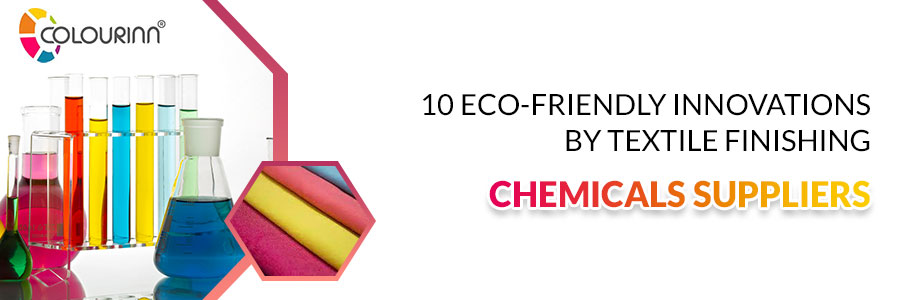With sustainability at the forefront of global innovation, Textile Finishing Chemicals Suppliers are stepping up to transform the industry. As consumers grow more environmentally conscious, the demand for eco-friendly solutions in every sector is on the rise. The textile industry, known for its substantial environmental footprint, is witnessing a sea change, with suppliers pioneering methods to reduce this impact. Let’s unfold the fabric of this transformation and explore ten groundbreaking eco-friendly innovations introduced by these suppliers.
Sustainable Dyeing Agents
Textile Finishing Chemicals Suppliers are innovating with sustainability at their core, introducing dyeing agents that marry environmental responsibility with vibrant textile production. Here’s a glimpse into these green advancements:
- Water-Based Pigments: A shift to water-based pigments by some Textile Finishing Chemicals Manufacturers reduces VOC emissions, providing a more environmentally friendly dyeing option.
- Biodegradable Dispersants: The development of biodegradable dispersants ensures that post-use, the environmental footprint of fabrics is significantly lowered.
Energy-Efficient Processes
The pursuit of energy conservation is reshaping the operations of Textile Finishing Chemicals Suppliers. By implementing new techniques, the industry is stepping into a more sustainable era:
- Cold Pad-Batch Dyeing: This method minimises energy usage by sidestepping the need for heat. Applying dyes at ambient temperatures not only conserves energy but also contributes to the longevity of fabrics.
- Plasma Treatment: As an innovative fabric finishing method, plasma treatment eschews water and chemical use, presenting a low-energy alternative that paves the way for sustainable manufacturing.
Waste Reduction Techniques
The leading manufacturers are also redefining waste management through advanced technology:
- Digital Printing Technology: Digital printing slashes waste by depositing ink precisely, minimizingg the excess typical of conventional printing practices.
- Enzyme-Based Finishes: Replacing harsh chemicals, enzymes provide eco-friendlier finishing for textiles, reducing waste and toxic byproducts in the process.
Eco-Conservation Efforts
A greener footprint is a target for suppliers as they revisit and revise their raw material sources:
- Natural Dye Initiatives: Reviving time-honoured methods, the industry is reintroducing plant and mineral-based dyes, which offer a less toxic alternative with a reduced carbon trail.
- Recycled Chemicals: Innovative suppliers are now turning potential waste into precious inputs by utilising recycled chemicals in their production cycles.
Advanced Material Use
Modern advancements meet eco-consciousness in the development of novel materials:
- Organic Performance Chemicals: The rise of organic chemicals for high-performance textiles is breaking the association between industrial excellence and environmental impact.
- Microencapsulation: By encasing active agents like antimicrobials in micro-capsules that bind to fabrics, this technology delivers enhanced textile functionalities without harming the ecosystem.
Innovative Resource Management
Textile Finishing Chemicals Suppliers are crafting strategies to use resources more judiciously, aiming for processes that give back to the environment as much as they take:
- Closed-Loop Water Systems: These systems represent a significant stride in resource conservation, recycling water in dyeing processes and preventing pollution.
- Solvent Recovery Plants: By capturing and reusing solvents in their facilities, suppliers are cutting down on emissions and reducing environmental toxicity.
Advanced Bio-Friendly Materials
The adoption of materials from nature is setting a new benchmark in the production of textiles:
- Chitosan-Based Finishing: This eco-friendly substance, derived from crustacean shells, is being used for non-toxic finishes that are both effective and biodegradable.
- Algae-Based Dyes and Prints: Algae emerge as a renewable resource for dyeing, offering a palette of possibilities with minimal ecological disruption.
Reduction in Carbon Footprint
Every step towards reducing carbon emissions is a leap towards a healthier planet:
- Carbon Capture: Innovative Textile Finishing Chemicals Manufacturers are now incorporating carbon capture in their processes to combat climate change actively.
- Low-Temperature Dyeing Chemicals: The development of new chemicals that adhere to fabrics at lower temperatures is slashing energy use and associated carbon emissions.
Technological Innovations for Sustainability
Technology is the catalyst for an eco-friendly transformation in the textile industry:
- Nanotechnology in Finishing: Nanotech is being harnessed to craft finishes that conserve water and energy while augmenting fabric features.
- AI-Driven Production Optimization: Artificial intelligence is enabling Textile Finishing Chemicals Manufacturers to streamline production, enhancing efficiency and sustainability.
Enhancing Biodegradability
The future of textiles lies in materials that leave no trace:
- Developing Biodegradable Polymers: Suppliers are at the forefront of engineering polymers that will degrade naturally, reducing long-term waste.
- Natural Wax Coatings: Turning to nature once more, natural waxes are being used for finishing, offering an environmentally benign alternative to traditional synthetic coatings.
Weaving a Greener Future – Colourinn’s Eco-Vision
Colourinn stands as an exemplary beacon among Textile Finishing Chemicals Suppliers, integrating these innovations with a commitment to sustainability. Our expertise in Textile Dyes & Auxiliaries not only embellishes fabrics but also endorses a greener approach to textile enhancement.
As a trusted Textile Auxiliary Manufacturer, Colourinn ensures that every product developed under our roof—from molecular conception to final dispatch—is aligned with the ethos of environmental responsibility. Our invitation extends to all—join us at Colourinn, where every colour we create and every service we offer is a step towards a brighter, more sustainable future.
Frequently Asked Questions
Q1. What significant environmentally friendly developments are available from manufacturers of textile finishing chemicals?
Ans. Water-based finishes, biodegradable treatments, and energy-efficient procedures are among the advancements introduced by textile finishing suppliers.
Q2. What role do these advances play in the textile industry’s sustainability?
Ans. Water conservation, waste reduction, and energy efficiency in textile production are some of the ways that eco-friendly innovations lessen their negative effects on the environment.
Q3. Will these advancements ultimately save businesses capital?
Ans. Certainly, since eco-friendly textile finishing techniques use fewer resources and have a higher market appeal, they do wind up being more affordable in the long run.

